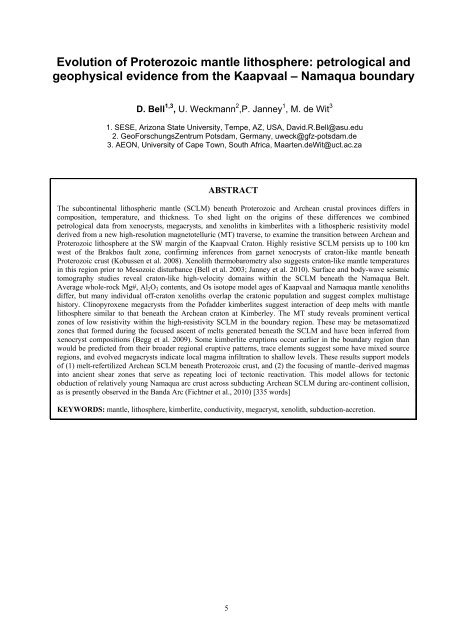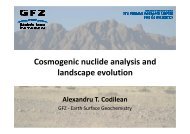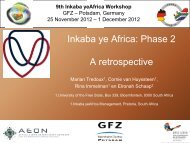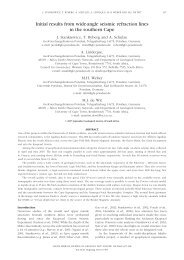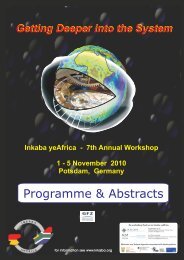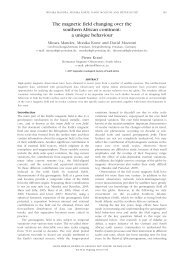South Africa - Inkaba.org
South Africa - Inkaba.org
South Africa - Inkaba.org
Create successful ePaper yourself
Turn your PDF publications into a flip-book with our unique Google optimized e-Paper software.
Evolution of Proterozoic mantle lithosphere: petrological and<br />
geophysical evidence from the Kaapvaal – Namaqua boundary<br />
D. Bell 1,3 , U. Weckmann 2 ,P. Janney 1 , M. de Wit 3<br />
1. SESE, Arizona State University, Tempe, AZ, USA, David.R.Bell@asu.edu<br />
2. GeoForschungsZentrum Potsdam, Germany, uweck@gfz-potsdam.de<br />
3. AEON, University of Cape Town, <strong>South</strong> <strong>Africa</strong>, Maarten.deWit@uct.ac.za<br />
ABSTRACT<br />
The subcontinental lithospheric mantle (SCLM) beneath Proterozoic and Archean crustal provinces differs in<br />
composition, temperature, and thickness. To shed light on the origins of these differences we combined<br />
petrological data from xenocrysts, megacrysts, and xenoliths in kimberlites with a lithospheric resistivity model<br />
derived from a new high-resolution magnetotelluric (MT) traverse, to examine the transition between Archean and<br />
Proterozoic lithosphere at the SW margin of the Kaapvaal Craton. Highly resistive SCLM persists up to 100 km<br />
west of the Brakbos fault zone, confirming inferences from garnet xenocrysts of craton-like mantle beneath<br />
Proterozoic crust (Kobussen et al. 2008). Xenolith thermobarometry also suggests craton-like mantle temperatures<br />
in this region prior to Mesozoic disturbance (Bell et al. 2003; Janney et al. 2010). Surface and body-wave seismic<br />
tomography studies reveal craton-like high-velocity domains within the SCLM beneath the Namaqua Belt.<br />
Average whole-rock Mg#, Al2O3 contents, and Os isotope model ages of Kaapvaal and Namaqua mantle xenoliths<br />
differ, but many individual off-craton xenoliths overlap the cratonic population and suggest complex multistage<br />
history. Clinopyroxene megacrysts from the Pofadder kimberlites suggest interaction of deep melts with mantle<br />
lithosphere similar to that beneath the Archean craton at Kimberley. The MT study reveals prominent vertical<br />
zones of low resistivity within the high-resistivity SCLM in the boundary region. These may be metasomatized<br />
zones that formed during the focused ascent of melts generated beneath the SCLM and have been inferred from<br />
xenocryst compositions (Begg et al. 2009). Some kimberlite eruptions occur earlier in the boundary region than<br />
would be predicted from their broader regional eruptive patterns, trace elements suggest some have mixed source<br />
regions, and evolved megacrysts indicate local magma infiltration to shallow levels. These results support models<br />
of (1) melt-refertilized Archean SCLM beneath Proterozoic crust, and (2) the focusing of mantle–derived magmas<br />
into ancient shear zones that serve as repeating loci of tectonic reactivation. This model allows for tectonic<br />
obduction of relatively young Namaqua arc crust across subducting Archean SCLM during arc-continent collision,<br />
as is presently observed in the Banda Arc (Fichtner et al., 2010) [335 words]<br />
KEYWORDS: mantle, lithosphere, kimberlite, conductivity, megacryst, xenolith, subduction-accretion.<br />
5


